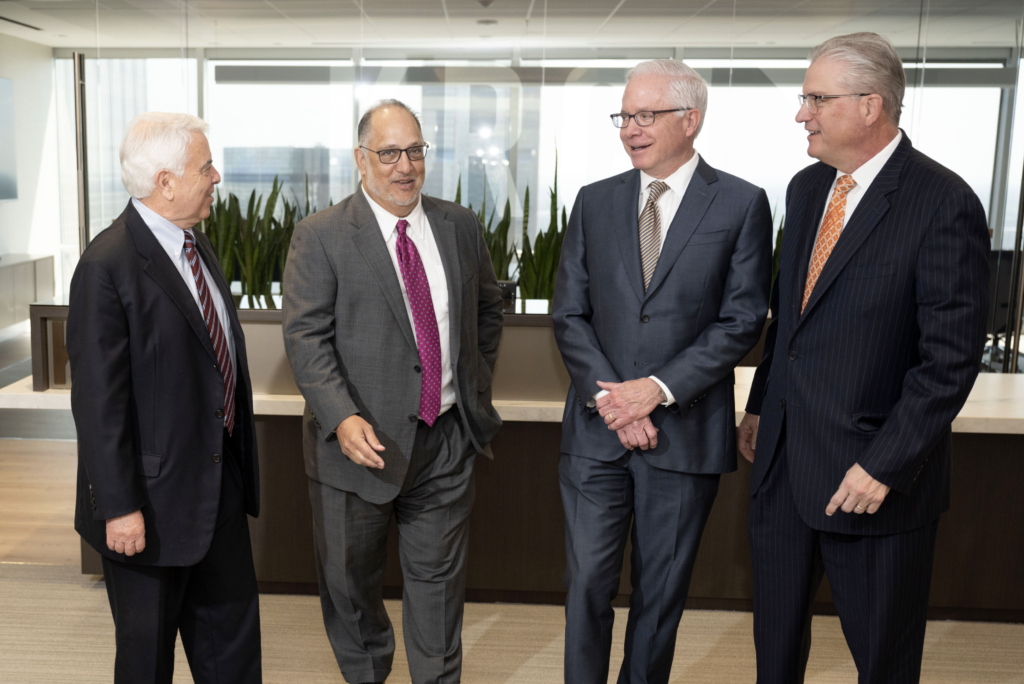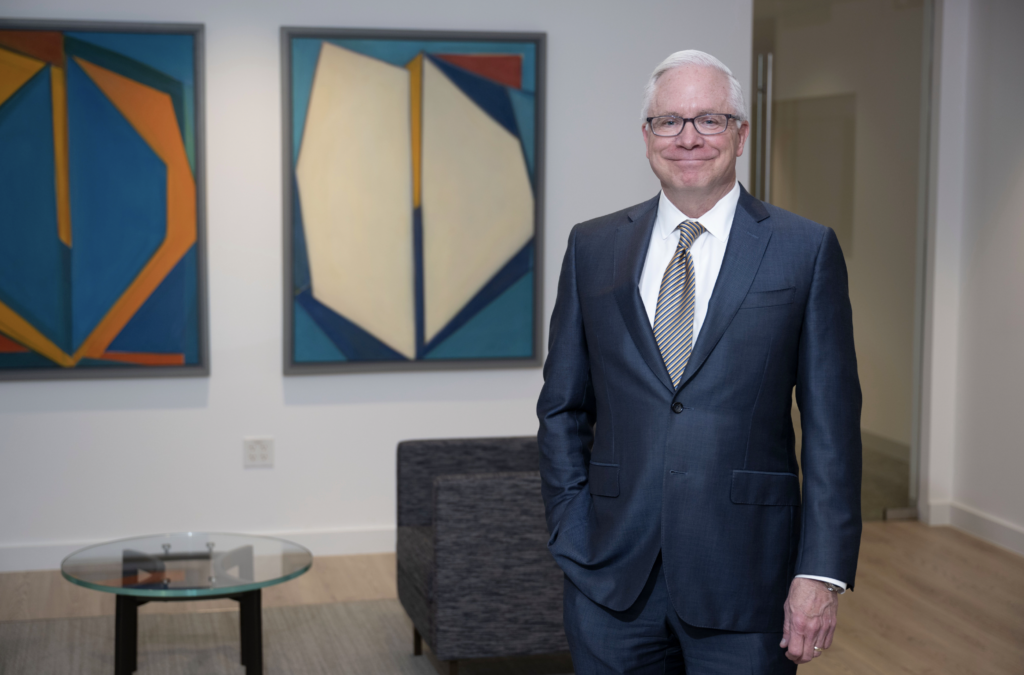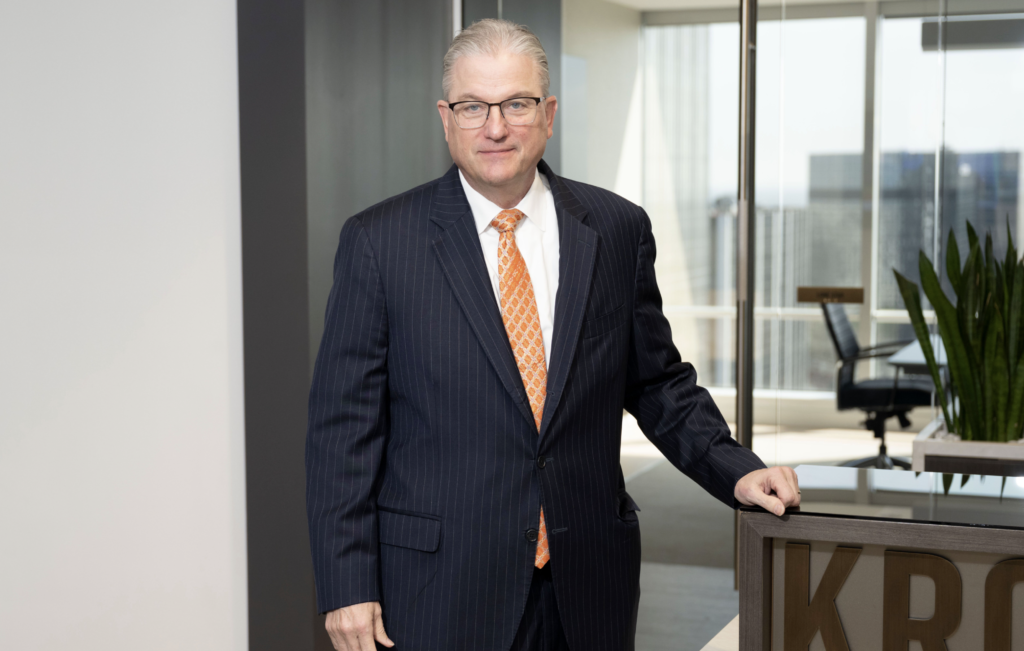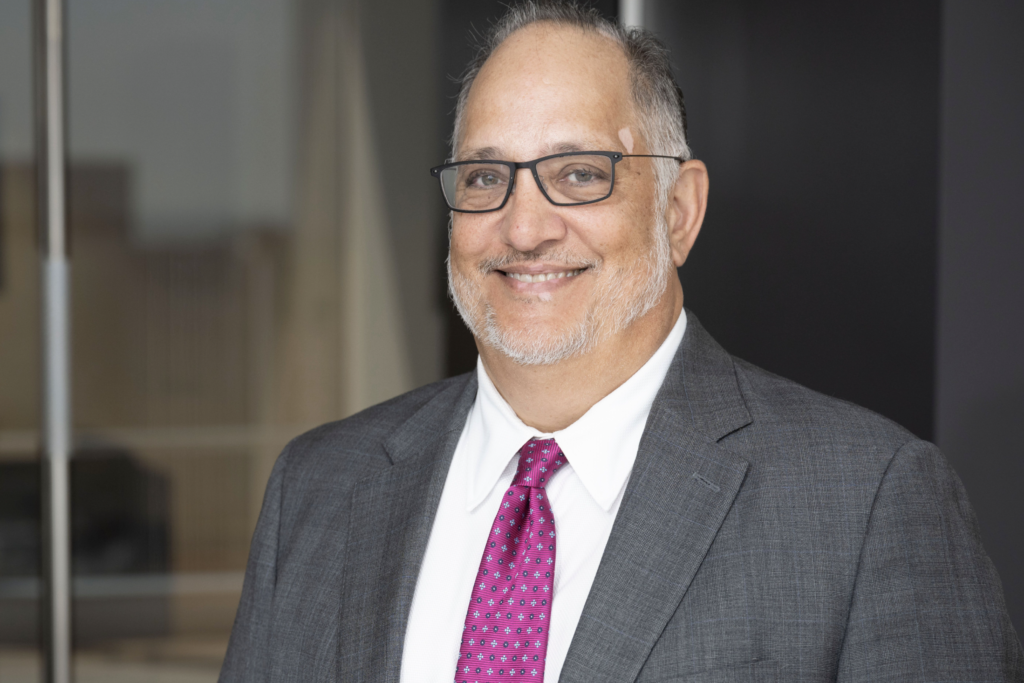
From left to right: KRCL founders Gordon Russell, Mike Logan, Raymond Kane and Joe Coleman at their offices.
Raymond Kane, Joe Coleman and Mike Logan huddled around the fax machine in their new downtown Dallas office at Fountain Place Plaza that they subleased for $5 a square foot from then-corporate legal giant Jenkens & Gilchrist.
“We sat in the office watching the faxes go through,” said Coleman, remembering the early months of 1992 when they informed their clients from their old firm that they were moving. “As soon as we heard the humming (of a client faxing back), we’d get excited. ‘Yes, that client is coming with us.’ The faxes kept coming.”
Photos by Jake Dean
The first letters were from Circuit City and EastPark National Bank confirming that they would become the new law firm’s first two corporate clients. Later that day, the trio celebrated at On the Border, which is now also a client.
Three decades later, Kane, Russell, Coleman & Logan ― KRCL to legal industry folks ― is celebrating its pearl anniversary.
KRCL, at age 30, is entrenched in the Texas middle market of corporate law firms. The firm ranks 46th in the 2021 Texas Lawbook 50, which grades corporate law firms in Texas based on revenue and headcount.
The Texas Lawbook 50 shows KRCL ended 2021 with more than 75 lawyers in Dallas and Houston and revenues that exceeded $47 million ― up more than five percent from 2020.
Circuit City is long gone, but firm clients include oil and gas producer EP Co., Highpoint Capital, REI, Trammell Crow, Guggenheim Retail Real Estate Partners and Tuesday Morning. The firm represents the FDIC and City of Las Vegas regularly in litigation.
Coleman, a bankruptcy lawyer, has represented creditors’ committees in 45 cases in 19 states. He’s advised major lenders in billion-dollar corporate restructurings such as Whiting Oil, Gavilan Resources, Arena Energy and Sheridan Holding Co.

Raymond Kane
“We can do anything a large New York corporate law firm can do but at much more reasonable rates,” Kane said.
Kane, Coleman, Logan and Gordon Russell, who joined the firm in May 1992, attribute their 30-year success to fiscal responsibility and an alternative culture that its big-firm competitors generally cannot promise.
“We do a lot of good for our employees, our clients and we have provided a very stable environment for people who want to become good lawyers,” Kane said.
“We ask our lawyers, ‘What is your higher priority ― investing in the future of the firm or maximizing this year’s profits?’” Coleman said. “We can make more money and have a much more satisfying practice if we can represent the client for 15 years. Every one of us has had a great year, every year for 30 years.”
“Who would have thought that we would have lasted longer than Jenkens & Gilchrist?” he said.
The roots of KRCL were seeded in the fall of 1991. Coleman and Logan, who had been practicing for six years, had just made partner at Baker, Smith & Mills. A few months later, the firm’s leaders announced in August 1991 a merger with the law firm of prominent trial attorney Joe Geary.
Suddenly, red flags surfaced.
“Joe Geary’s biggest client was the wife of our biggest client and they were getting a divorce and we were told our client has to go,” Logan said.
The decision to merge led Coleman to ask to see the firm’s financials.

Joe Coleman
“The firm was in trouble,” Coleman said. “As a young partner, I looked at the financial data and I was baffled. I had a conversation with the managing partner and he had no answers.”
Instead, the managing partner asked Coleman to present his calculations to the management committee.
“Right there I said, ‘If you need me to do this, then you have bigger problems,’” Coleman said.
Kane, Coleman and Logan sat at the dining table in Kane’s house weeks later discussing forming a firm together.
The three lawyers told their old firm on Jan. 2, 1992, they were leaving.
But their new firm’s success was far from assured. During the transition between firms, Coleman woke from a nightmare at 3 a.m.
“I told my wife with two young kids that I just had a dream that we were all living in our car,” he said. “That didn’t go over well.”
KRCL’s third client was real-estate tycoon Craig Hall, the client Logan was told he would be losing as a result of the Geary merger.
“When we told him we couldn’t do his work anymore he was pretty upset,” Logan recalled. “On Jan. 2 or 3, Joe and I went to Craig Hall’s office and said we had started a firm and would like his business back. He was our largest client for the first couple of years.”
The four lawyers agree that obtaining the subleased office space from Jenkens & Gilchrist for $5 a square foot was critical. “You don’t need the Taj Mahal,” quipped Kane, noting that their predecessor firm had just signed a lease at the Trammell Crow building for $35 a square foot.
Two associates from their old firm joined them at their new operation. Both of those associates later became directors and have since retired. By the end of KRCL’s first year, the firm had 10 lawyers.
Kane said the four knew nothing about the business side, but “we knew how not to run a law firm.”
“Working lawyers have to be rewarded. If you don’t, the hard-working and producing lawyers will leave,” Kane said.
Also: “Don’t take a lot of risk and don’t borrow money,” he added. “Our rent today is not more than half of what the Trammell Crow lease was 30 years ago.”
“We don’t pay ourselves with borrowed money,” Russell said.

Gordon Russell
That said, the founders secured a loan in 1992 to cover office equipment and basic expenses. They got a $150,000 loan and a $150,000 line-of-credit from Malcom Holland, the lending officer at EastPark National Bank, KRCL’s second client.
“These guys came to me to get a loan based on receivables that they had not yet collected or even billed to buy some equipment that was worth 10 cents on the dollar,” said Holland, now the CEO of Veritex Holdings, one of KRCL’s largest clients.
“I made a loan when I probably shouldn’t have but I made it on the basis of character, which I’ve become pretty good at,” Holland said. “They’re super high-integrity, high-character guys. As a banker, you have to give people chances from time to time. They always passed the character test — all of them. They were incredibly fiscally responsible.”
Holland also helped the founders move into their new office.
“I remember the first weekend I went with Joe and I carried boxes up to their office,” Holland said. “They didn’t have a moving company — they were the moving company.”
KRCL expanded through the early 2000s in lawyer count and in successful client matters, carving their mid-market path.
On the M&A side, the firm represented an international energy company in 2011 in a multi-party acquisition with assets in Turkey. The deal featured eight law firms and eight national jurisdictions, including the U.S., British Virgin Islands and the Netherlands.
In 2005, the firm was engaged in a significant litigation matter for Elizabeth “Beth” Kerr, a granddaughter and heir of Mary Kay Ash. Kerr became embroiled in an eight-year legal battle involving a trust for which she was beneficiary against her uncle, Richard Rogers, who was also board chairman and CEO of Mary Kay Cosmetics. The case allowed KRCL to work on a straight contingent fee basis and raised the firm’s profile after all was done among the feuding family members.
Like all successful law firms, the leaders had to make difficult business decisions throughout the years.
By 2016, KRCL reached 98 attorneys and $52 million in revenues. But the firm’s leadership decided to focus on increasing revenues per lawyer and profits per partner.
The result: More than a dozen lawyers in the torts and insurance defense practice were asked to leave the firm because the practice was severely limited in the rates it could charge clients.
“They are excellent trial lawyers and even better people. It was simply a case of our visions taking different directions,” Logan said of the insurance defense group, led by Zach Mayer. “We spent three months providing accounting, HR and technology assistance to help them start their own firm.”
While total headcount and overall revenues took a hit for a few years, the firm significantly increased its revenue per lawyer by more than 25 percent over the past four years to $684,000 in 2021.
Sixty percent of the firm’s revenues comes from litigation.
With additional hires this year, KRCL now has 82 attorneys in its two offices. The leaders say they want to hire more attorneys, but that the Texas legal market for talent is overly competitive.

Mike Logan
“We looked to hire 10 lawyers during the past month or so, but we were only able to hire five,” Logan said. “We realize we cannot win the battle for talent on money.”
Russell said the firm needs to stress culture to attract talent.
“We compete with Big Law for the best associates, but we stress that the associates or even young partners will control their own destiny here,” Russell said. “We have to be more careful in whom we recruit. When we do get one of them, our victories are that much sweeter.”
In 2018, Kane, Russell, Coleman and Logan – who are 64, 74, 62 and 61, respectively – engaged in succession planning and took several steps to prepare the next generation of leaders at the firm. The firm incorporated a new governance structure at the beginning of 2020 that involved the four name shareholders significantly scaling down on leadership roles.
The firm elected a new board that did not include any of the name directors and only one equity director. The founders hired consultants to coach their non-equity directors on business development skills and assist with governance structure. They also formed practice groups that were not led by any equity directors, providing the future generation of leaders instead with the opportunity.
None of the four founders has immediate plans to retire. All four still work 40-plus hours a week — “full-time plus,” as they put it.
Although Logan “talks about it,” he said his “actions don’t reflect [his] BS.”
“I like it too much,” he said.
“My wife encouraged me not to retire,” Coleman said.
Worst day in 30 years? When they learned Gordon Russell had been diagnosed with cancer. Today, Russell is a three-time cancer survivor.
“There were a couple of days where it didn’t look good and it was horrible,” Coleman said. “I was at the hospital and it was bad.”
“Then, the next day, I yelled at him for not getting his hours in on time,” Coleman said.
